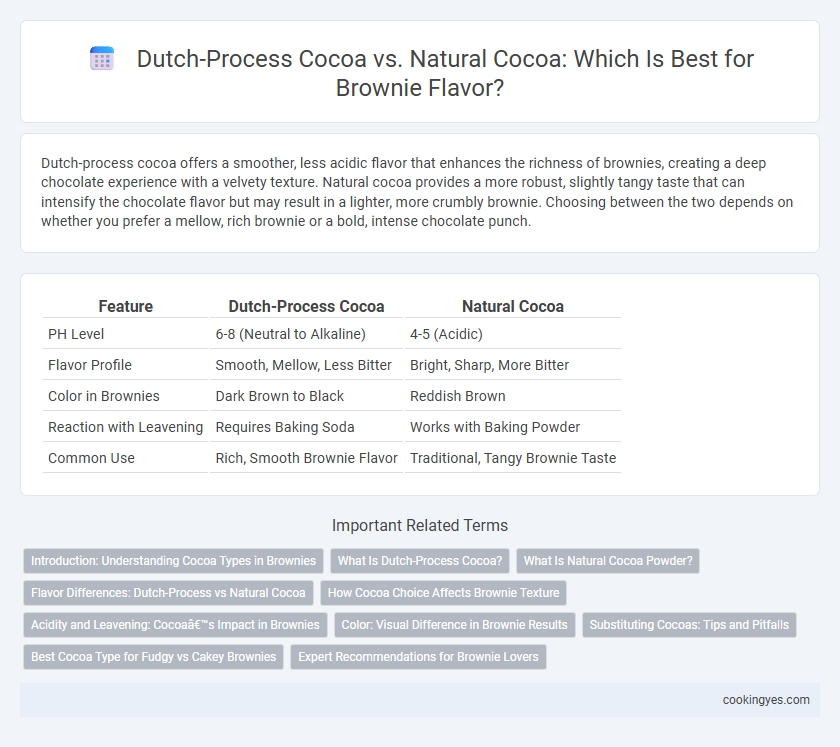Dutch-process cocoa offers a smoother, less acidic flavor that enhances the richness of brownies, creating a deep chocolate experience with a velvety texture. Natural cocoa provides a more robust, slightly tangy taste that can intensify the chocolate flavor but may result in a lighter, more crumbly brownie. Choosing between the two depends on whether you prefer a mellow, rich brownie or a bold, intense chocolate punch.
Table of Comparison
| Feature | Dutch-Process Cocoa | Natural Cocoa |
|---|---|---|
| PH Level | 6-8 (Neutral to Alkaline) | 4-5 (Acidic) |
| Flavor Profile | Smooth, Mellow, Less Bitter | Bright, Sharp, More Bitter |
| Color in Brownies | Dark Brown to Black | Reddish Brown |
| Reaction with Leavening | Requires Baking Soda | Works with Baking Powder |
| Common Use | Rich, Smooth Brownie Flavor | Traditional, Tangy Brownie Taste |
Introduction: Understanding Cocoa Types in Brownies
Dutch-process cocoa undergoes alkaline treatment, resulting in a smoother, less acidic flavor ideal for rich, velvety brownies. Natural cocoa retains its acidity, providing a sharper, more intense chocolate taste that reacts with baking soda to create rise and texture. Choosing between Dutch-process and natural cocoa significantly influences the flavor profile and texture of brownies.
What Is Dutch-Process Cocoa?
Dutch-process cocoa is cocoa powder treated with an alkalizing agent to neutralize its acidity, resulting in a darker color and smoother, milder flavor compared to natural cocoa. This alkalization enhances the cocoa's solubility in liquids, making it ideal for richer, less tangy brownies with a deep chocolate taste. Using Dutch-process cocoa in brownies creates a more mellow and less acidic flavor profile, preferred in recipes that include baking powder instead of baking soda.
What Is Natural Cocoa Powder?
Natural cocoa powder is made from roasted cocoa beans that are ground into a fine powder without any alkalizing treatment, preserving its acidic pH and bold, fruity flavor. It contains higher acidity than Dutch-process cocoa, which helps activate baking soda in brownie recipes, contributing to the classic rise and rich texture. The natural cocoa's bright and sharp chocolate notes intensify the deep, fudgy taste essential for traditional brownies.
Flavor Differences: Dutch-Process vs Natural Cocoa
Dutch-process cocoa undergoes alkalization, resulting in a smoother, milder flavor and darker color compared to natural cocoa, which retains a more acidic, robust, and fruity profile. Natural cocoa provides a sharper, tangier taste that enhances the traditional chocolate intensity in brownies, while Dutch-process offers a richer, more mellow chocolate experience with less bitterness. Choosing between the two affects the brownie's flavor complexity and texture, influencing whether the final product leans toward bold acidity or smooth chocolate richness.
How Cocoa Choice Affects Brownie Texture
Dutch-process cocoa undergoes alkalization, which reduces acidity and creates a smoother, more mellow flavor, resulting in brownies with a tender, cake-like crumb. Natural cocoa retains its acidity, contributing to a sharper, fruitier taste and creating a denser, fudgier texture in brownies. The choice between Dutch-process and natural cocoa directly impacts the brownie's moistness, crumb structure, and flavor intensity.
Acidity and Leavening: Cocoa’s Impact in Brownies
Dutch-process cocoa has a neutral pH around 7, reducing acidity and minimizing the need for acidic leavening agents, resulting in a smoother, more mellow brownie flavor. Natural cocoa is acidic with a pH of about 5-6, which reacts with baking soda to produce carbon dioxide, creating a lighter, tender crumb in brownies but a sharper, more pronounced chocolate taste. Choosing between Dutch-process and natural cocoa alters both the chemical leavening reaction and the overall flavor profile, impacting texture and acidity balance in brownies.
Color: Visual Difference in Brownie Results
Dutch-process cocoa produces a darker, more intense brown color in brownies compared to the lighter, reddish hue from natural cocoa due to its alkalized treatment. This color difference stems from the neutral pH of Dutch-process cocoa neutralizing acidic compounds, which preserves a deep chocolate shade during baking. Brownies made with natural cocoa exhibit a brighter, more reddish tone that visually indicates slight acidity and a fruitier flavor profile.
Substituting Cocoas: Tips and Pitfalls
Dutch-process cocoa, treated with an alkalizing agent, offers a smoother, less acidic profile ideal for rich, velvety brownies, while natural cocoa's sharp acidity reacts with baking soda to provide lift and a more pronounced chocolate flavor. Substituting one for the other without adjusting leavening agents can result in dense or overly bitter brownies. For best results, match Dutch-process cocoa with baking powder and natural cocoa with baking soda to maintain the desired texture and flavor balance in brownies.
Best Cocoa Type for Fudgy vs Cakey Brownies
Dutch-process cocoa has a smoother, less acidic flavor that enhances the rich, deep chocolate profile ideal for fudgy brownies, promoting a dense and moist texture. Natural cocoa offers a brighter, more acidic taste which interacts with baking soda to provide lift and a lighter crumb, making it perfect for cakey brownies. Choosing Dutch-process cocoa helps achieve intense, velvety fudgy brownies, while natural cocoa supports airy, tender cakey brownies.
Expert Recommendations for Brownie Lovers
Expert recommendations for brownie lovers often favor Dutch-process cocoa for its smooth, mellow flavor and deeper chocolate color, enhancing the rich taste and appearance of brownies. Natural cocoa offers a brighter, tangier flavor with higher acidity, which can interact with baking soda to create a lighter texture. For optimal brownie flavor, experts suggest using Dutch-process cocoa when desiring a classic, robust chocolate experience and natural cocoa for recipes emphasizing a more complex, slightly acidic bite.
Dutch-process cocoa vs Natural cocoa for brownie flavor Infographic

 cookingyes.com
cookingyes.com